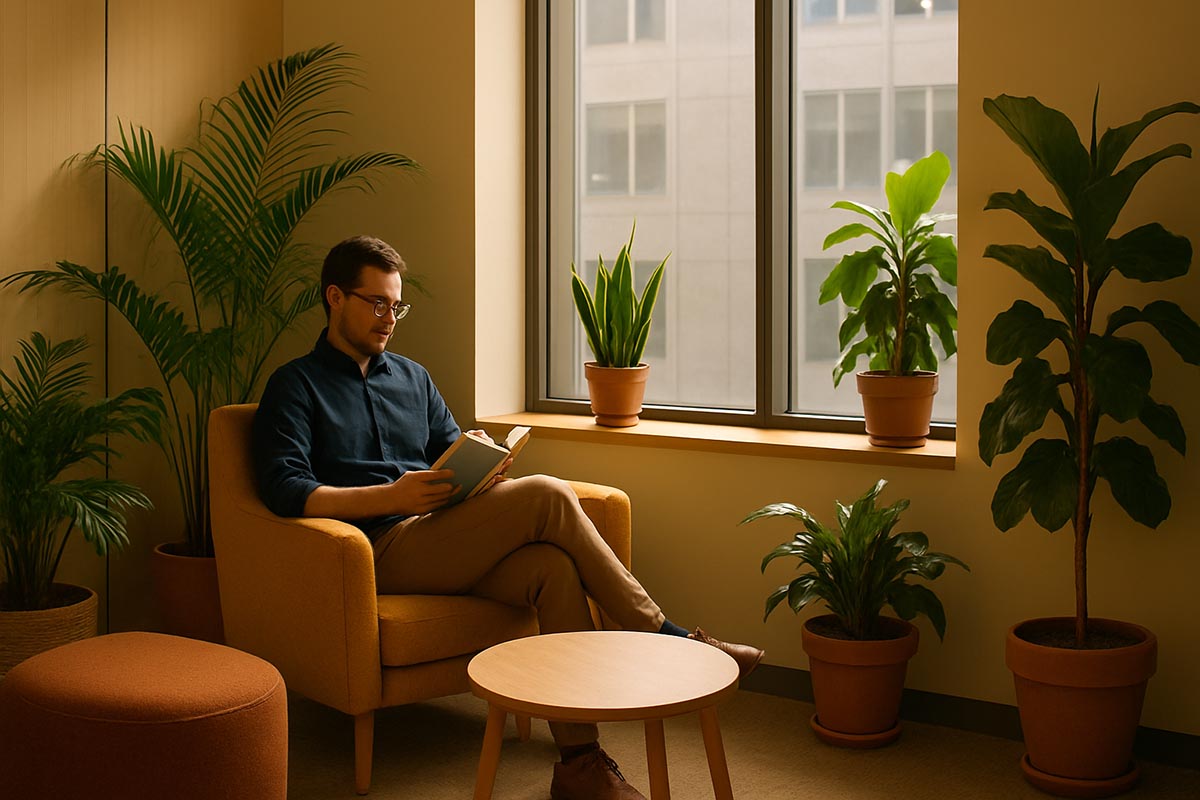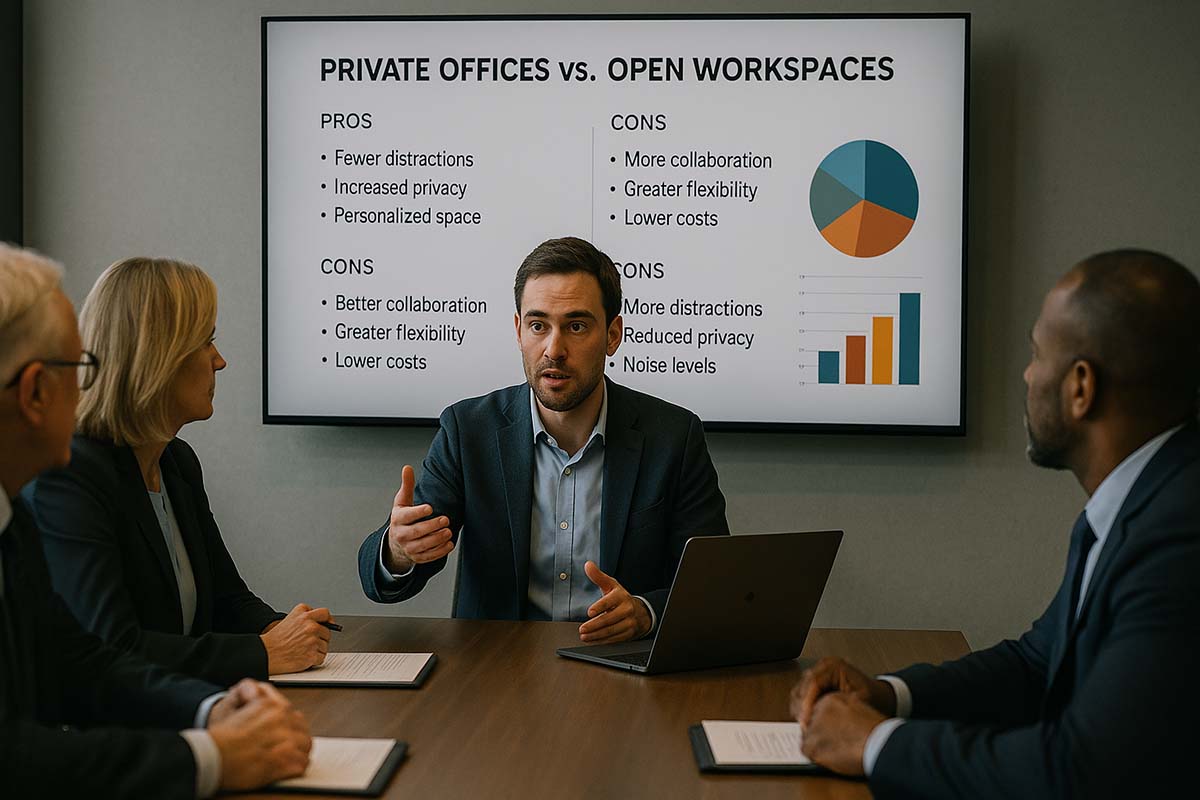How Office Design Impacts Productivity
Office Design and Its Impact on Productivity
Many believe that hard work and persistence are all it takes to perform well. But studies from around the world show there’s another silent factor at play—the design and layout of the workplace. With the right lighting, fresh airflow, and smooth movement around the space, energy and motivation tend to rise. For professionals and business owners across major cities, office design isn’t just about looks—it’s a strategic tool.
A productive workplace is built on three key foundations:
• Human-centered layout that balances collaboration with quiet focus.
• Healthy surroundings—natural light, clean air, and elements inspired by nature.
• Flexible space supported by technology and hybrid systems.
Data from international studies show that when these features are in place, employee satisfaction can rise by up to 75%, and actual output can increase by 6–15%.
Designing Spaces Around People
From Berlin to São Paulo, more companies are moving away from oversized open plans. Research in London shows that employees who sit near windows and can control their surroundings stay more focused and are more open to interaction when needed.
On the flip side, desks placed against blank walls often lead to more distractions. The key takeaway is to design the space like a village—vibrant areas for collaboration and quieter corners for deep work.
Some firms are even introducing mini-libraries or meditation zones. These additions not only offer mental breaks but also boost morale. People tend to feel more valued when their environment supports their well-being.
Light and Brightness: Creating Mental Clarity
Natural light is often called the “vitamin” of the office. A 2024 study found that a balance of sunlight, proper LED lighting, and adjustable brightness helps improve concentration while reducing fatigue.
It doesn’t just cut down electricity costs. It also helps maintain better sleep patterns, which is vital for mental energy. For offices with fewer windows, tunable white lighting and automated curtains can mimic the movement of daylight indoors.
Studies have shown that exposure to natural light during work hours is linked to better sleep quality and fewer midday energy dips. People working in well-lit spaces also report higher levels of focus and even improved mood.
Air, Materials, and Breathing Space
When the air smells of chemicals or the airflow is poor, even the most hardworking minds start to slow down. Leading companies now track CO₂ levels to ensure it stays below 1,000 ppm. When it drops closer to 800 ppm and air-purifying plants are present, focus improves and task completion speeds up by 8%.
This also highlights the importance of materials—low-VOC paint, eco-friendly flooring, and sound-absorbing walls reduce both toxins and noise distractions.
Good air quality is also linked to fewer sick days. When ventilation is poor, airborne illnesses can spread faster. Offices that prioritize cleaner air often see better attendance and fewer reported headaches or allergies among their teams.
Simple Elements That Energize a Workplace
- Indoor plants that freshen the air and add color
- Ergonomic chairs and desks that prevent back pain
- Modular furniture for quick layout changes
- Private pods or booths for quiet phone calls
These items can fit into most office designs without large budgets. The real value comes from thoughtful planning.
Office elements like mood boards or digital screens for team recognition can also make a difference. When employees feel appreciated and comfortable, they are more motivated to give their best.
Flexible Tech and Adaptable Work Zones
Reports show coworking spaces grew by more than 15% annually after 2024. A major reason is their ability to offer flexible areas equipped with strong internet, smart booking systems, and real-time data on space usage.
Knowing which spots are crowded or quiet helps people choose the best place for their work, boosting both speed and comfort.
This kind of setup is especially useful for hybrid workers. If someone comes into the office twice a week, having the right space available—whether it’s a focus pod or a casual meeting area—makes those days more productive.
Color Culture and Brand Identity
Colors have a direct impact on how people feel. Soft blues and greens help with focus, while energetic shades like orange or yellow spark creativity. In Copenhagen, a fintech center painted their quiet zones muted green and their brainstorming areas tangerine. After three months, self-reported energy levels rose by 12%.
Even something as simple as changing wall colors seasonally or using colored lights during events can keep the environment fresh and exciting.
Some organizations align their color themes with their brand values. A company promoting sustainability might use earthy tones and natural wood accents. Meanwhile, a tech startup could go for bold, futuristic palettes to energize their team.
Lessons from Cities Worldwide
Sydney
Here, the connection between nature and office design was strengthened through rooftop gardens, giving workers a refreshing break space during lunch.
Nairobi
This city made use of locally sourced wood and natural airflow to adjust to the tropical weather. The result? Lower electricity bills and improved attendance.
Toronto
Ceilings were fitted with sound-masking panels and rooms were added for multi-faith use. This helped create a sense of belonging among the staff.
Amsterdam
Some firms replaced traditional desks with standing tables and flexible beanbag zones. This setup encouraged more spontaneous collaboration.
These stories remind us that there’s no one-size-fits-all approach. The best layout is the one that fits a place’s climate, culture, and type of work.
Measuring Impact: Numbers That Matter
Good feelings are helpful, but hard data is better. In a workplace study conducted in 2024–2025 by CBRE, many organizations are shifting from counting heads to measuring how well the space works.
By gathering employee feedback, tracking how fast tasks are completed, and observing how space is used, companies get a clear picture of whether their design investments are paying off.
Some offices now use sensor platforms to monitor sound, foot traffic, and changes in temperature. These are displayed on dashboards available to facility and HR teams for better decision-making.
This trend shows that data isn’t just for finance teams anymore. Facilities and people operations are now looking closely at analytics to keep teams happy and healthy.
Adapting to the Hybrid Setup
As three-day office schedules become more common, layouts are being adjusted too. Desks don’t have to disappear, but they’re now organized into zones: a quiet pod for solo tasks, a social hub for casual chats, and a team room with whiteboards for busy project weeks.
Adding digital kiosks for booking desks and wireless tools for presentations helps employees understand where they’ll be most effective.
This flexibility ensures that no one feels out of place. Whether you’re a coder who needs silence or a designer who thrives on spontaneous feedback, there’s a space designed for your style of working.
A Fresh Perspective
When a workspace aligns with people’s needs—with good lighting, clean air, and a layout that supports both calm and connection—productivity and well-being naturally improve. Office design, in this case, is more than just aesthetics. It becomes the foundation for happier days and better work results.









